Color can completely recast the personality of a fireplace, turning dull brick, dated stone, or plain drywall into the room’s undisputed focal point. With today’s heat-rated latex formulations that tolerate up to about 250 °C, it’s remarkably safe and simple to coat surrounds, mantels, and even fireboxes when they’re cool to the touch. Selecting products labeled “fireplace-safe” further guards against peeling and fumes during high-temperature cycles. Whether you crave bright, airy neutrals or bold, dramatic hues, strategic paint unlocks virtually endless design possibilities—often for far less money and mess than full demolition or tile work, as interior remodelers repeatedly prove. Explore these twenty fresh fireplace paint ideas and imagine how quickly your own hearth could shine.
1. Crisp White Fireplace Brightening Paint
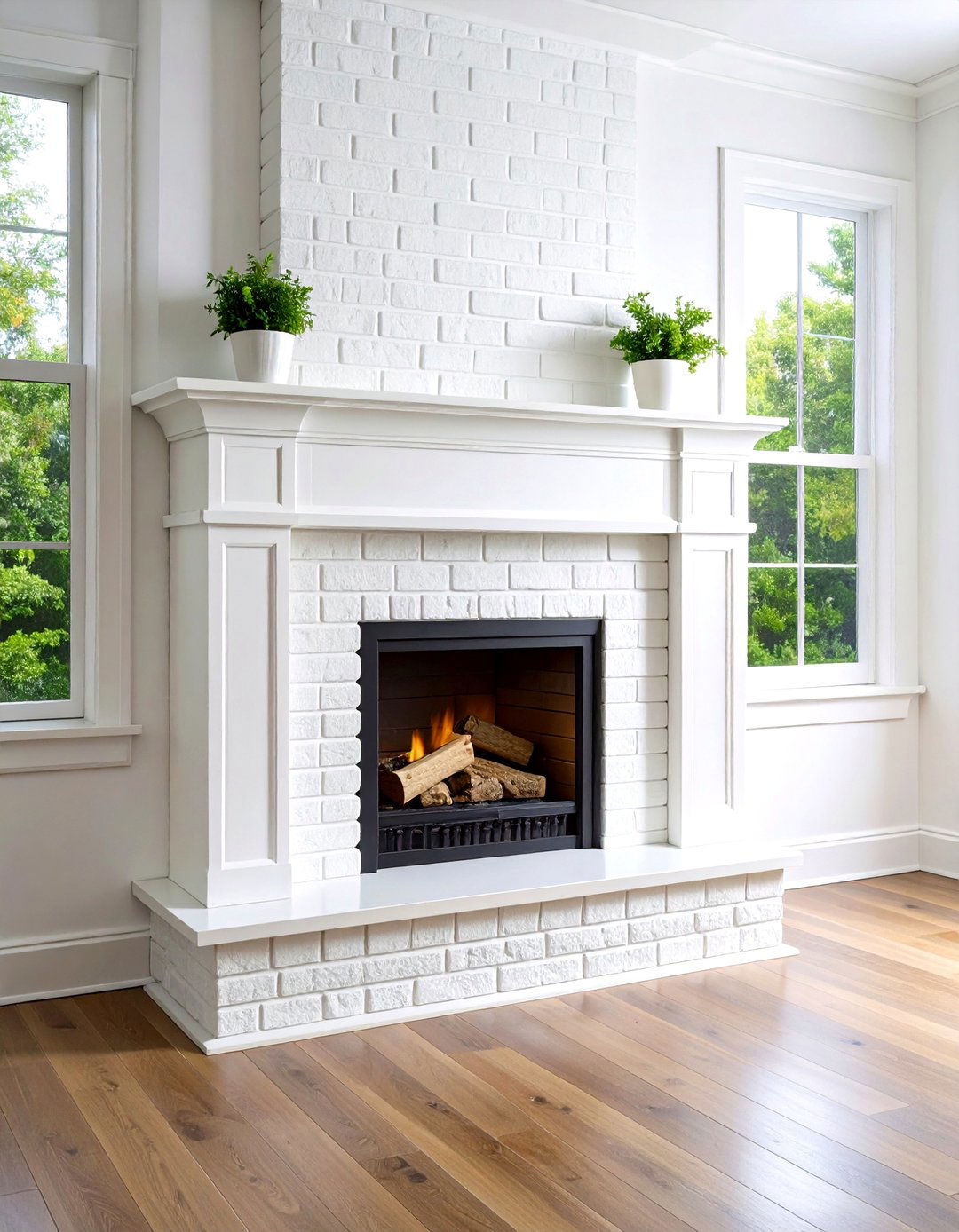
A sparking white fireplace instantly softens heavy brick and floods the room with reflected light, making adjacent walls, floors, and furnishings feel larger and cleaner. Designers recommend a high-hide, eggshell or satin latex formulated for masonry, rolled on in two thin coats so the mortar lines maintain crisp definition. Because soot and smoke can gray porous brick, prime first with a stain-blocking bonding primer rated for 200 °F or higher to keep the fresh hue pure year after year. Finish by caulking gaps around the surround, then style the mantel with layered neutrals to accentuate the fireplace’s new cloud-like presence without overwhelming its calm simplicity.
2. Moody Matte Black Fireplace Statement
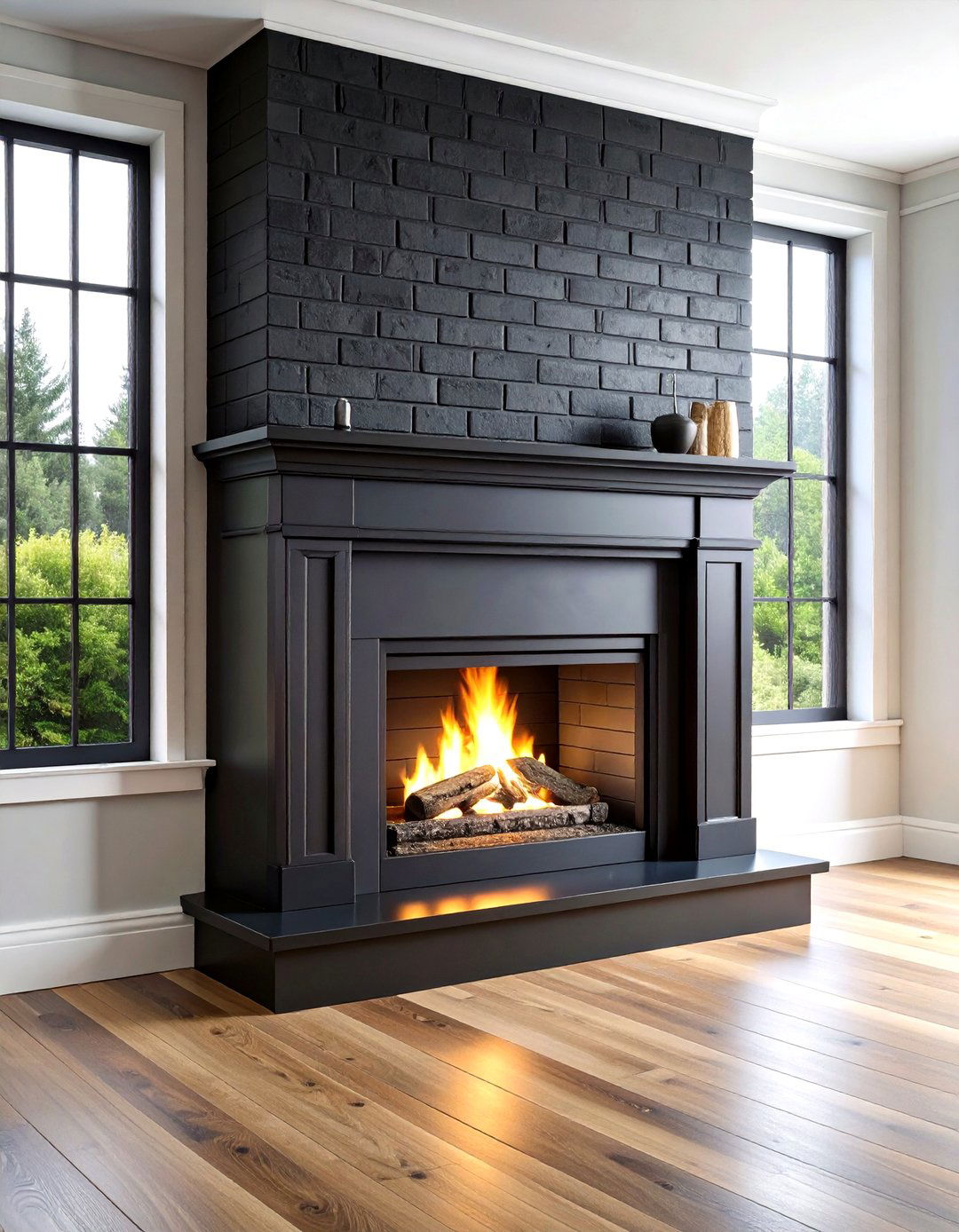
Opting for a matte black fireplace flips the traditional notion of a bright hearth, creating a dramatic anchor that instantly modernizes cottage or mid-century rooms alike. Deep charcoal or true black masonry paint emphasizes architectural lines and disguises minor imperfections in worn brick. Use a low-sheen, high-heat enamel on the inner firebox for a seamless shadow effect, and balance the intensity with pale walls or natural wood tones so the space remains welcoming. Homeowners love that soot buildup is visibly reduced against the dark surface, allowing longer intervals between touch-ups while delivering the luxe, gallery-like mood now trending for 2025 interiors.
3. Warm Greige Fireplace for Subtle Neutral

Choosing a greige fireplace—somewhere between gray and beige—adds understated sophistication without the sterility of pure white or the boldness of black. The chameleon quality means the color shifts warmly under evening lamplight yet reads cooler beside daylight, harmonizing with most furniture palettes. Professionals suggest testing large swatches above the mantel because undertones can amplify when exposed to flame glow or LED strips. A washable, heat-resistant latex rated for 150 °F or more stands up to occasional sparks yet cleans easily with mild soap. Pair the greige finish with brushed-nickel firescreens and woven baskets to highlight the fireplace’s inviting, neutral backbone.
4. Coastal Blue Fireplace Accent

A serene coastal-blue fireplace echoes sea and sky, supplying a subtle pop of color that still feels timeless beside crisp neutrals. Designers working with monochromatic schemes note that layering several tints of the same hue on walls, built-ins, and accessories deepens visual interest while keeping the palette cohesive. Choose a mid-tone mineral-based masonry paint with built-in primer so the brick’s surface texture shows through, giving the finish a beach-washed vibe. Because blues can intensify when the fire is lit, keep the mantel décor airy—think bleached wood, woven rope, or vintage glass—to complete the relaxed, shoreline-inspired fireplace statement.
5. Quick Chalk-Paint Fireplace Refresh
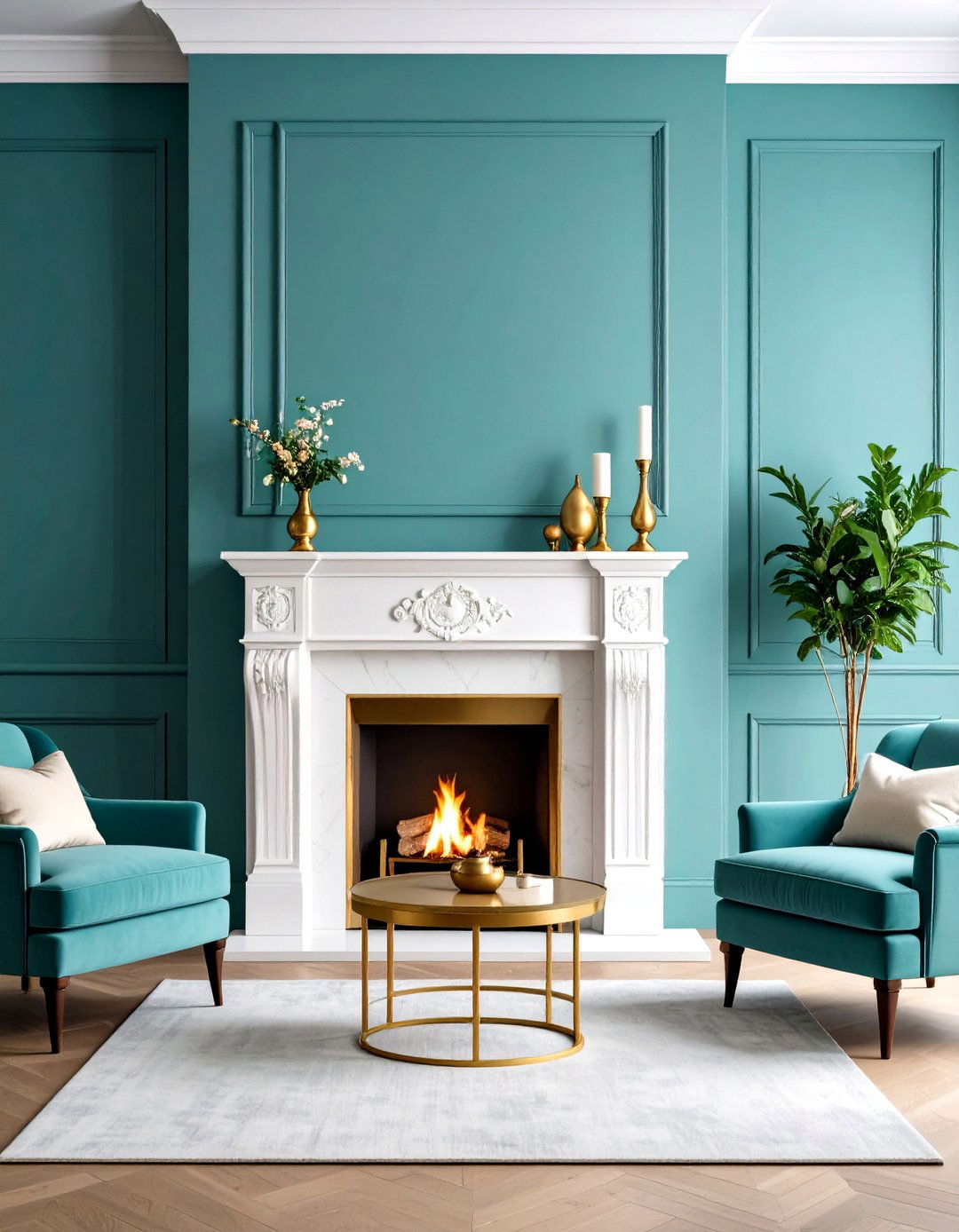
Chalk paint offers the fastest route to a refreshed fireplace because it adheres to brick, tile, and marble with minimal sanding and dries in under an hour per coat. Mix the soft, ultra-matte finish with clear wax around the firebox for additional durability, or seal the whole surround with a satin polyurethane approved for 200 °F exposures. The velvety surface diffuses shadows, making an uneven hearth look intentionally aged instead of dated. Try layering two close chalk shades—one brushed lightly over the other—to create depth and subtle movement, then accent the matte fireplace with glossy brass tools for satisfying textural contrast.
6. Textured German Smear Fireplace Finish
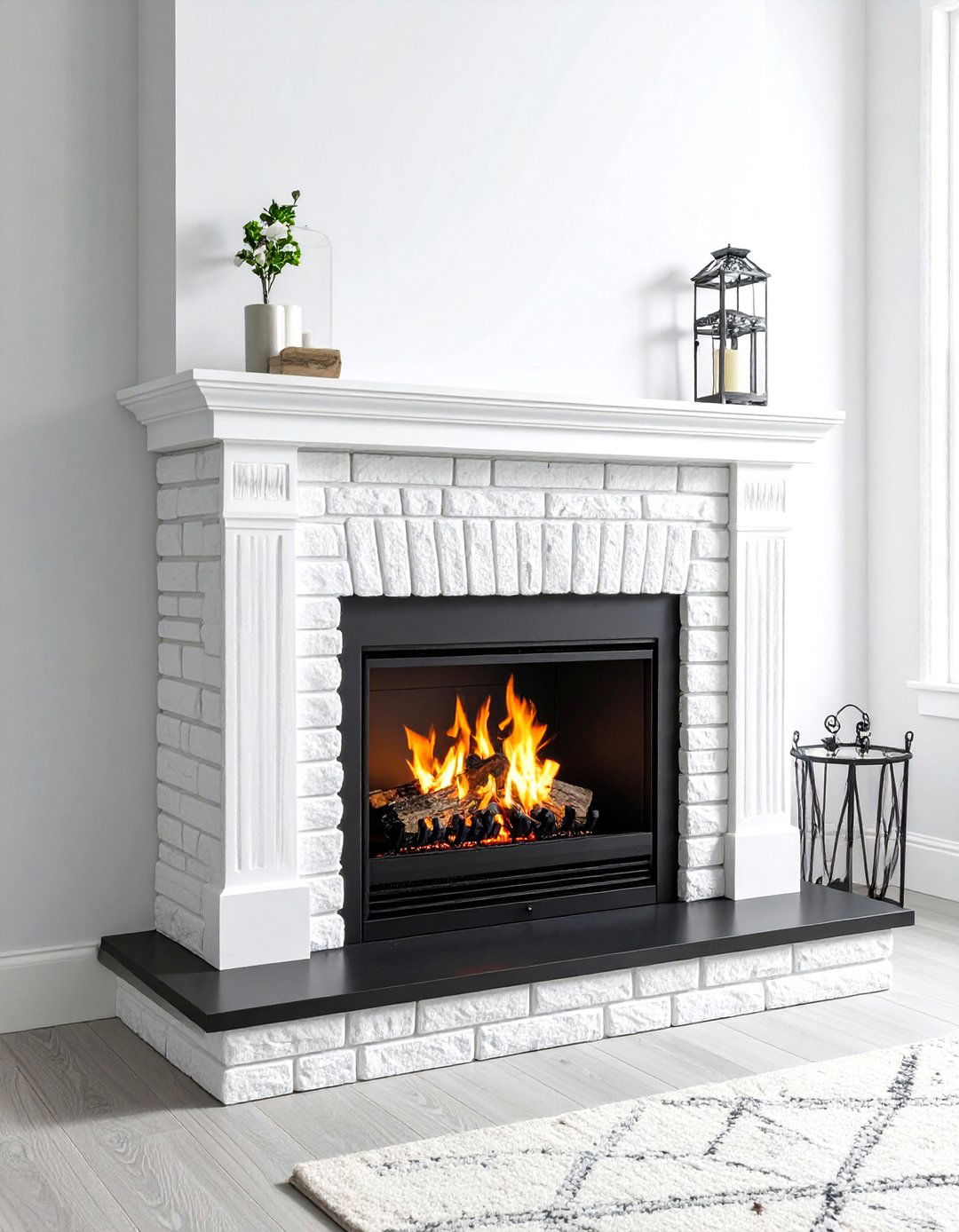
Applying a German smear—essentially troweling thin mortar over painted or bare brick—adds Old-World texture that reads handcrafted and hides repair scars. Paint the brick a contrasting base color first, such as slate or mocha, so glimpses show through the smeared white mortar for instant patina. Because mortar withstands high temperatures naturally, you can extend the technique into the firebox throat without specialty coatings. Keep joints irregular and wipe random bricks nearly clean to avoid a flat look, then seal with a breathable matte masonry sealer to deter soot. Finish the mantel with forged iron accents to underline the continental character.
7. Breathable Limewash Fireplace for Old-World Softness

Limewash, made from crushed limestone and water, penetrates fireplace brick instead of forming a surface film, so it will not peel and allows masonry to breathe naturally. The translucence creates depth, letting hints of original brick peek through while muting harsh orange tones. Mix pigment into the limewash for custom tints, then mist the brick lightly as you work; added moisture helps the coating soak in evenly. Any areas you dislike can be rubbed back with water within the first day for remarkable control over the mottled effect. Seal only if heavy soot is expected, preserving the chalky, heritage-inspired fireplace finish.
8. Two-Tone Fireplace Mantel and Surround Contrast
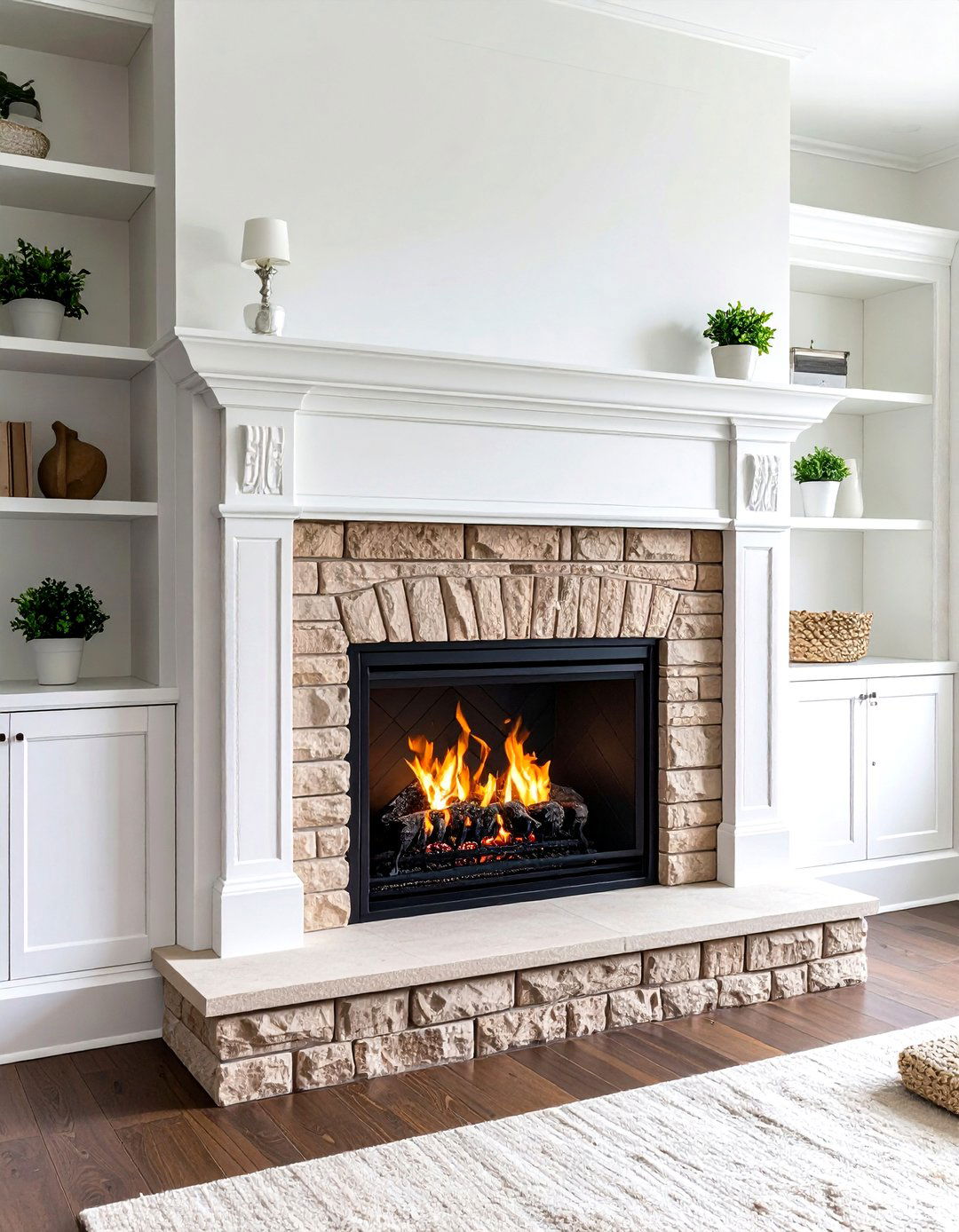
Painting the fireplace surround one hue and the mantel or trim another instantly highlights architectural layers that often go unnoticed. Homeowners gravitate toward pairing soft clay surrounds with crisp white mantels or vice versa for a tailored, built-in look. Tape precise lines along crown edges and corbels, then roll the lighter color first to avoid bleeding onto darker accents. For cohesion, repeat the mantel color on adjacent shelving or window casings. Ensure both paints share the same sheen—typically low-luster satin—in formulas rated at least 150 °F so cleaning and touch-ups remain straightforward. This simple contrast turns an ordinary fireplace into a crafted, furniture-like focal point.
9. Wall-Color-Matched Monochrome Fireplace
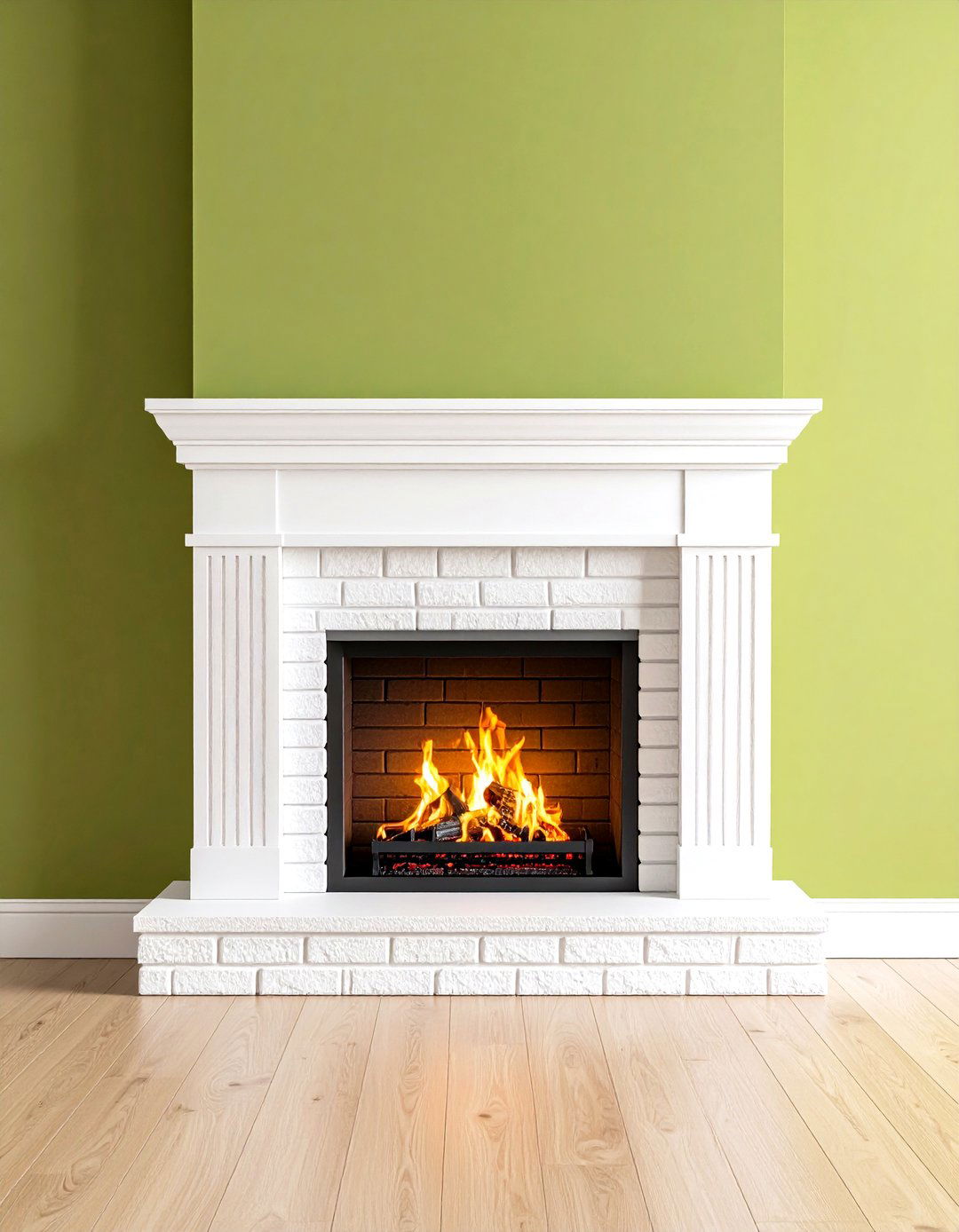
Painting the fireplace the exact shade as surrounding walls erases visual breaks and lets furniture or art take center stage. Design editors credit the growing monochrome trend with giving even small living rooms a sense of expansiveness by unifying planes into one continuous envelope. Use the same finish level—matte, eggshell, or velvet—on both surfaces, but opt for the masonry version to tolerate radiant heat. Because color saturation may appear deeper on textured brick than on smooth drywall, consider cutting the fireplace mix with ten percent white to maintain a seamless match. The result is a subtle, architectural fireplace that whispers rather than shouts.
10. Calming Sage Green Fireplace Cocoon
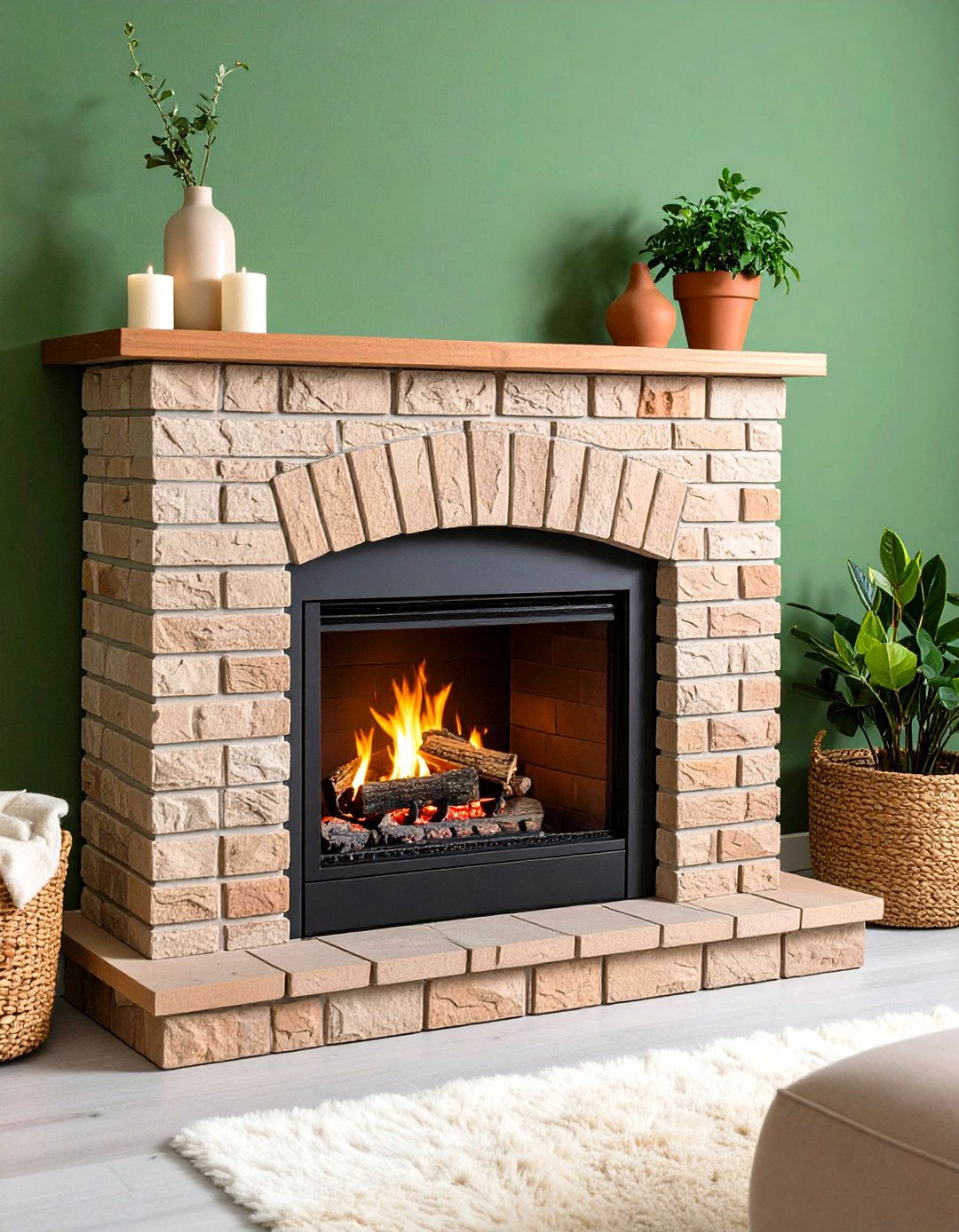
A sage green fireplace introduces a soothing, nature-inspired backdrop that pairs effortlessly with both warm timbers and sleek metals. Color forecasters praise mid-tone sages like Saybrook Sage for their ability to read as a colored neutral, bringing depth without overpowering nearby hues. In living rooms, the olive undertone complements house-plant foliage, making the entire vignette feel intentional. Use a satin masonry formula to resist fingerprints; matte finishes can look dusty against the soft green. Cap the palette with creamy linen textiles and vintage terracotta pots to echo the fireplace’s earthy yet refined personality. Even small hearths gain cozy gravitas in this muted shade.
11. Industrial Charcoal Gray Fireplace Edge
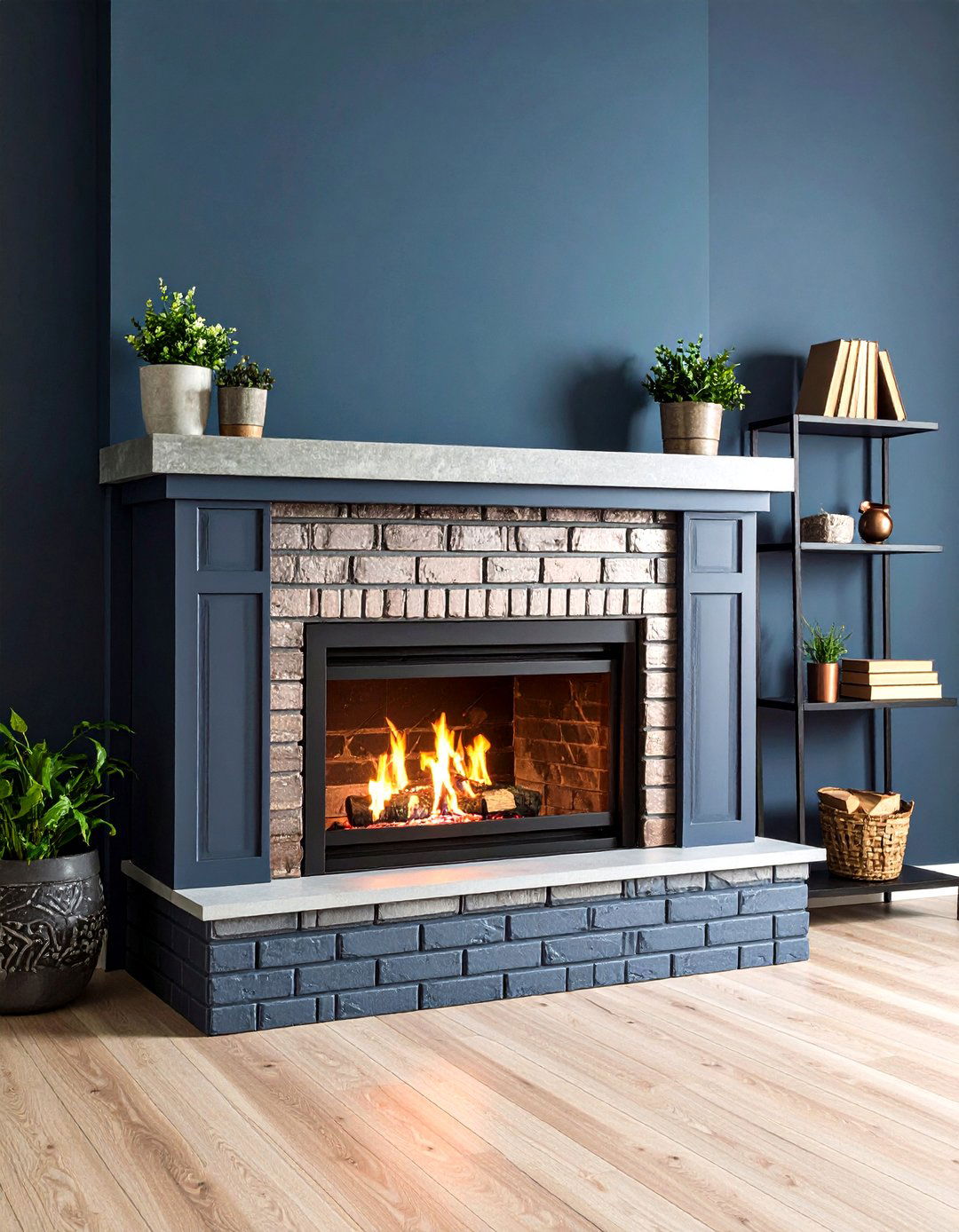
Rich charcoal gray strikes a balance between black’s drama and lighter neutrals’ versatility, giving the fireplace an urban loft feel that still plays nicely with softer textures. Paint pros advise choosing a formulation with subtle metallic fleck to catch firelight and prevent the surface from reading flat at night. Prep by degreasing soot, then roll two coats in different directions to minimize lap marks on porous brick. Because gray masks ash better than pale colors, maintenance is minimal; simply wipe with a damp microfiber cloth between seasons. Pair the industrial fireplace with concrete planters or steel shelving for a cohesive, modern edge.
12. Earthy Terracotta Fireplace Warmth

A terracotta fireplace brings the sun-baked charm of Mediterranean tile into any climate, radiating inviting warmth even when the fire is unlit. Images of clay-toned hearths trending on design boards show how the dusty orange pairs beautifully with woven cane, leather, and greenery for casual elegance. Because red-orange pigments are naturally strong, start with a masonry primer tinted halfway to the final shade to avoid extra coats. Finish with a water-based sealer containing UV inhibitors; terracotta fades faster than cooler colors in bright rooms. The resulting fireplace feels handcrafted and earthy—perfect for anchoring global, boho, or rustic interiors today.
13. Stormy Navy Fireplace Drama

Deep navy on a fireplace captures the moody sophistication of classic libraries while still reading fresher than black. Monochromatic color-scheme guides highlight how layering one hue in multiple textures—painted brick, velvet pillows, glazed ceramics—creates an immersive cocoon. Choose a color with gray undertones so the blue doesn’t skew primary when the flames glow. Because dark blues may show dust, finish with scrubbable satin enamel rated to at least 200 °F, then run a soft brush across the brick as paint sets to expose subtle highlights. Brass or unlacquered copper accessories pop brilliantly against the stormy navy fireplace backdrop tonight effortlessly.
14. Soft Blush Fireplace Surprise

A blush-pink fireplace may sound daring, but the muted, dusty versions designers favor read almost like warmed limestone, adding a discreet whisper of color ideal for Scandinavian or cottage interiors. Keep undertones beige rather than bubble-gum and pair with ivory grout to secure an adult, architectural feel. Because pink pigments tend to be low in hide, plan on three thin coats with a high-bond primer underneath. The payoff is a fireplace that glows at sunset and flatters skin tones during gatherings. Layer in linen upholstery and natural oak to ground the delicate hue and keep the hearth feeling calm, not precious.
15. Cozy Taupe Fireplace that Blends In
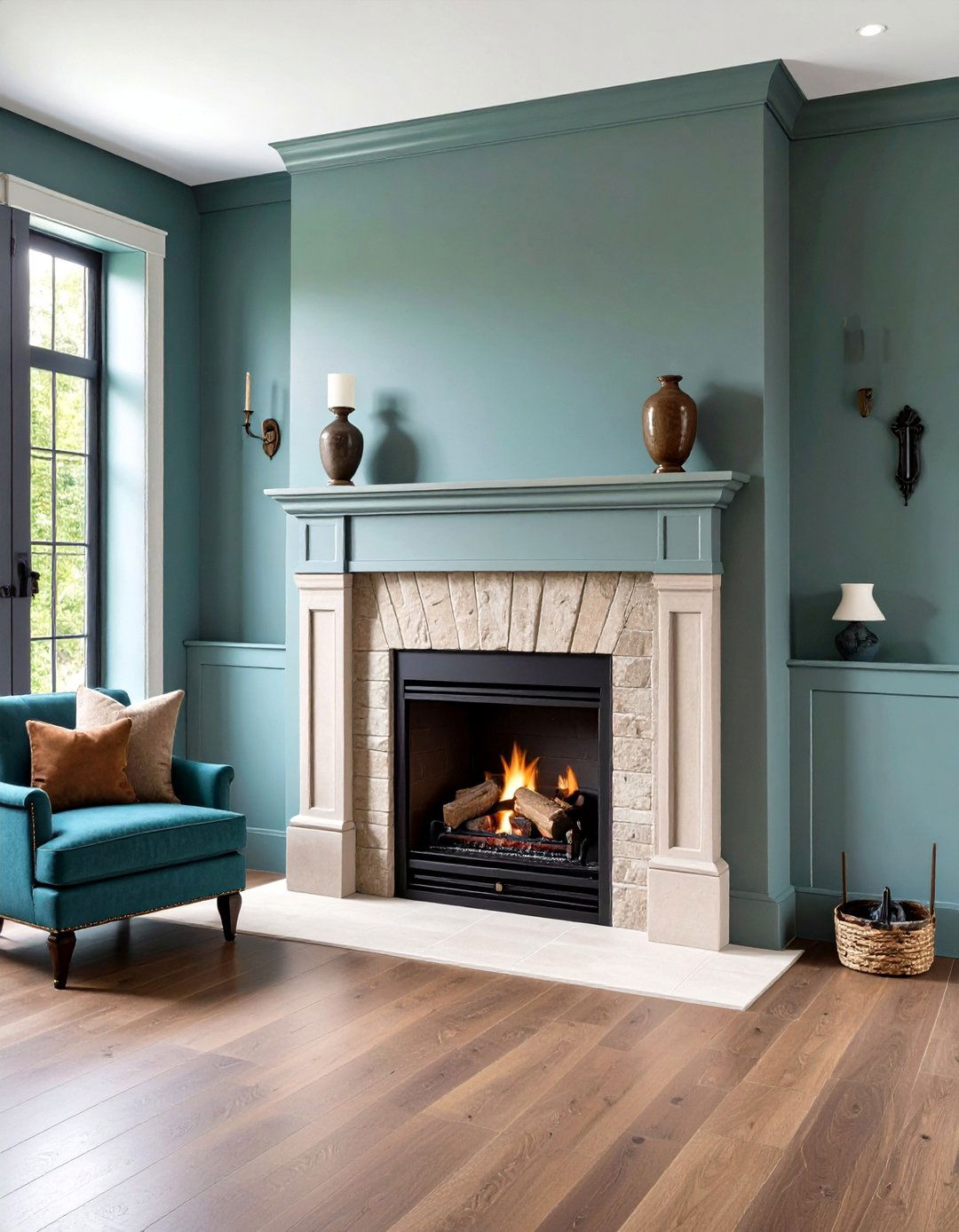
Taupe fireplaces excel in open-concept spaces where you want the hearth to complement, not compete with, sprawling kitchen cabinetry or built-ins. Interior stylists rely on the color’s mix of brown and gray to harmonize woods, metals, and fabrics in a single stroke. Select a mid-sheen paint so the finish absorbs just enough light, preventing the fireplace from looking plastic. Because taupe covers well, two coats usually suffice after a stain-blocking primer. Complete the look with tonal stoneware and leather pulls on nearby storage to reinforce the cohesive palette. Guests may not notice the taupe fireplace immediately—but they’ll feel the room’s unified calm.
16. Graphic Stenciled Fireplace Pattern

Applying a stencil over a solid-color fireplace injects pattern without the permanence or cost of tile. Design editors suggest geometric or Moroccan motifs sized to a single brick for easiest alignment. Tape off the firebox and roll the background color first; when dry, affix the stencil with repositionable spray adhesive and dab on contrasting masonry paint using a nearly dry foam roller to prevent bleed. Seal with matte polyurethane rated for fireplace surrounds so flash doesn’t distract from the pattern. The technique works equally on plaster, concrete, or brick, turning the fireplace into a bespoke art installation for a few weekends’ effort.
17. Subtly Metallic Bronze Fireplace Sheen
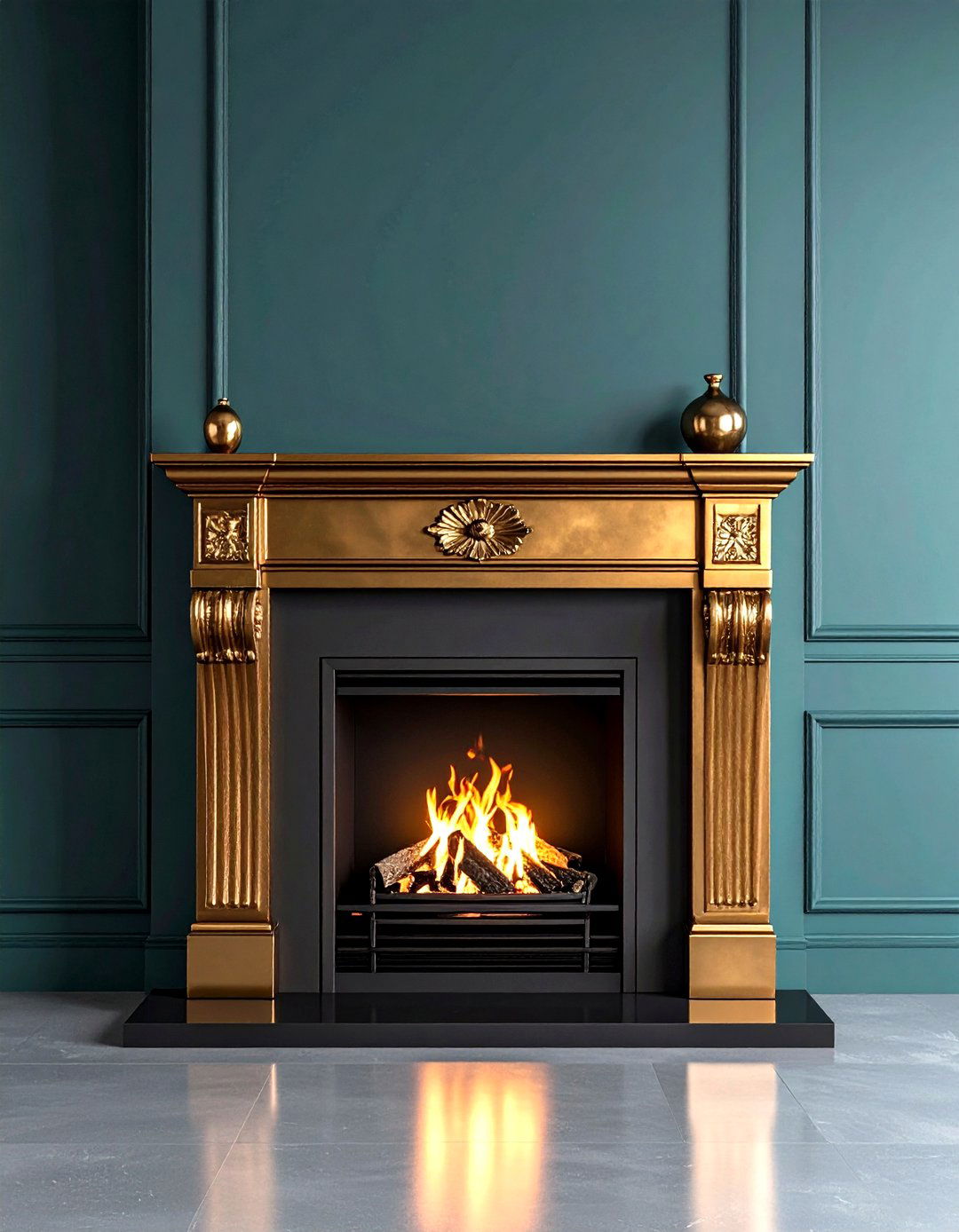
Brushed bronze paint introduces a subtle gleam that catches firelight without slipping into gaudy territory. Inspiration galleries show metal-toned fireplace surrounds adding Art-Deco glamour to otherwise simple living rooms. Start with a charcoal base coat, then layer thin metallic glaze using a soft cloth in irregular strokes so highs and lows develop naturally. Because metallic pigments can magnify roller texture, always finish with a wide synthetic sash brush that you feather lightly before the surface sets. Protect the shimmer with a clear, heat-resistant topcoat to stop tarnish. The finished fireplace reads like aged metalwork—rich, tactile, and surprisingly low maintenance.
18. Soft Whitewashed Stone Fireplace
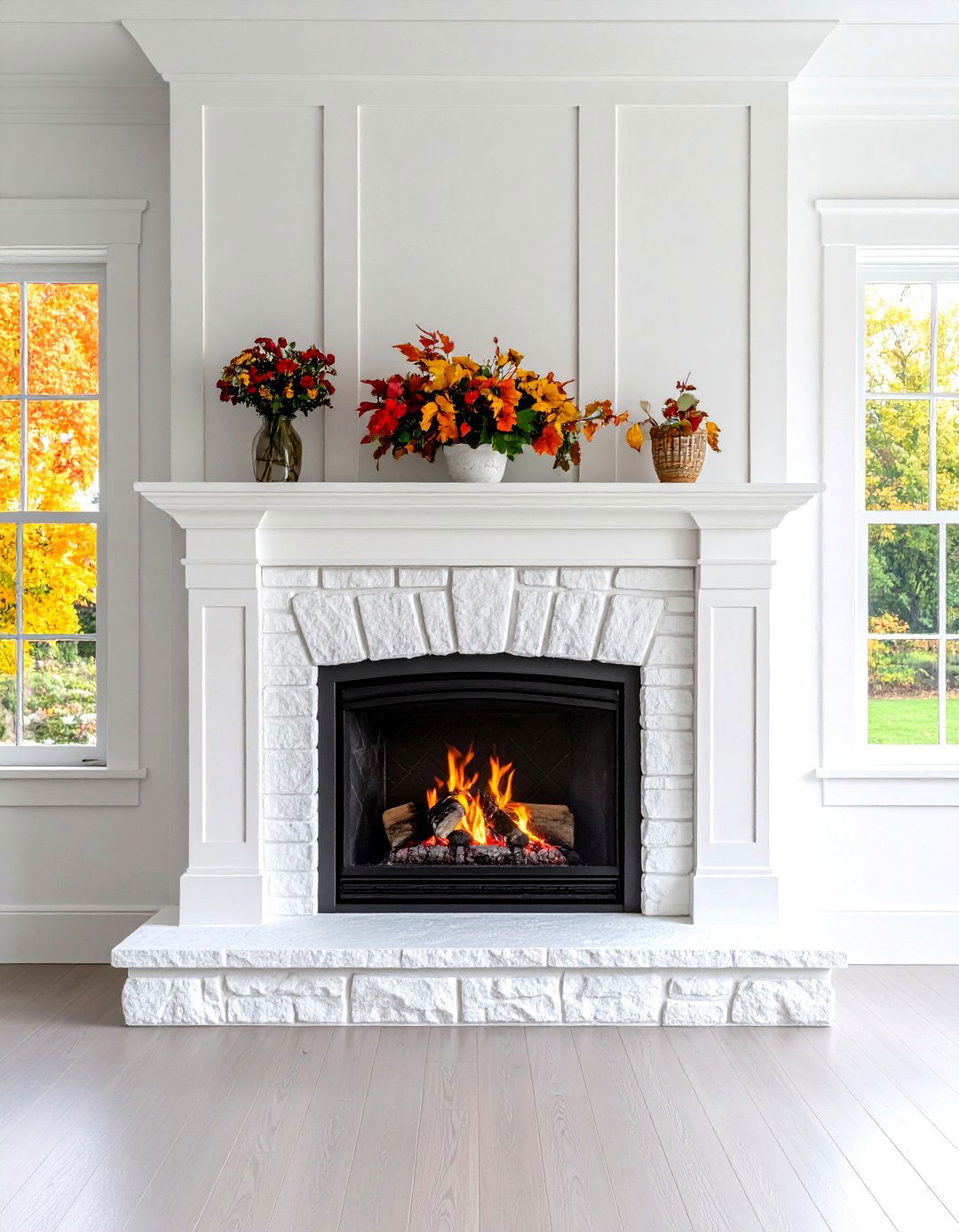
Whitewashing a heavy stone fireplace mutes busy multicolored rocks and unifies the surround while still celebrating natural variations below. DIYers debating limewash versus paint find that a thinned-out latex whitewash is easier to control and touch up indoors, though it may require reapplication every five to seven years. Dilute paint one-to-one with water, brush liberally, then wipe stones selectively to achieve the desired translucency. Because stone absorbs unevenly, work in small sections and step back often to keep tones balanced. Finish with breathable matte sealer to block soot staining without adding unwanted sheen, preserving the fireplace’s breezy, cottage character.
19. Ombre Gradient Fireplace Fade
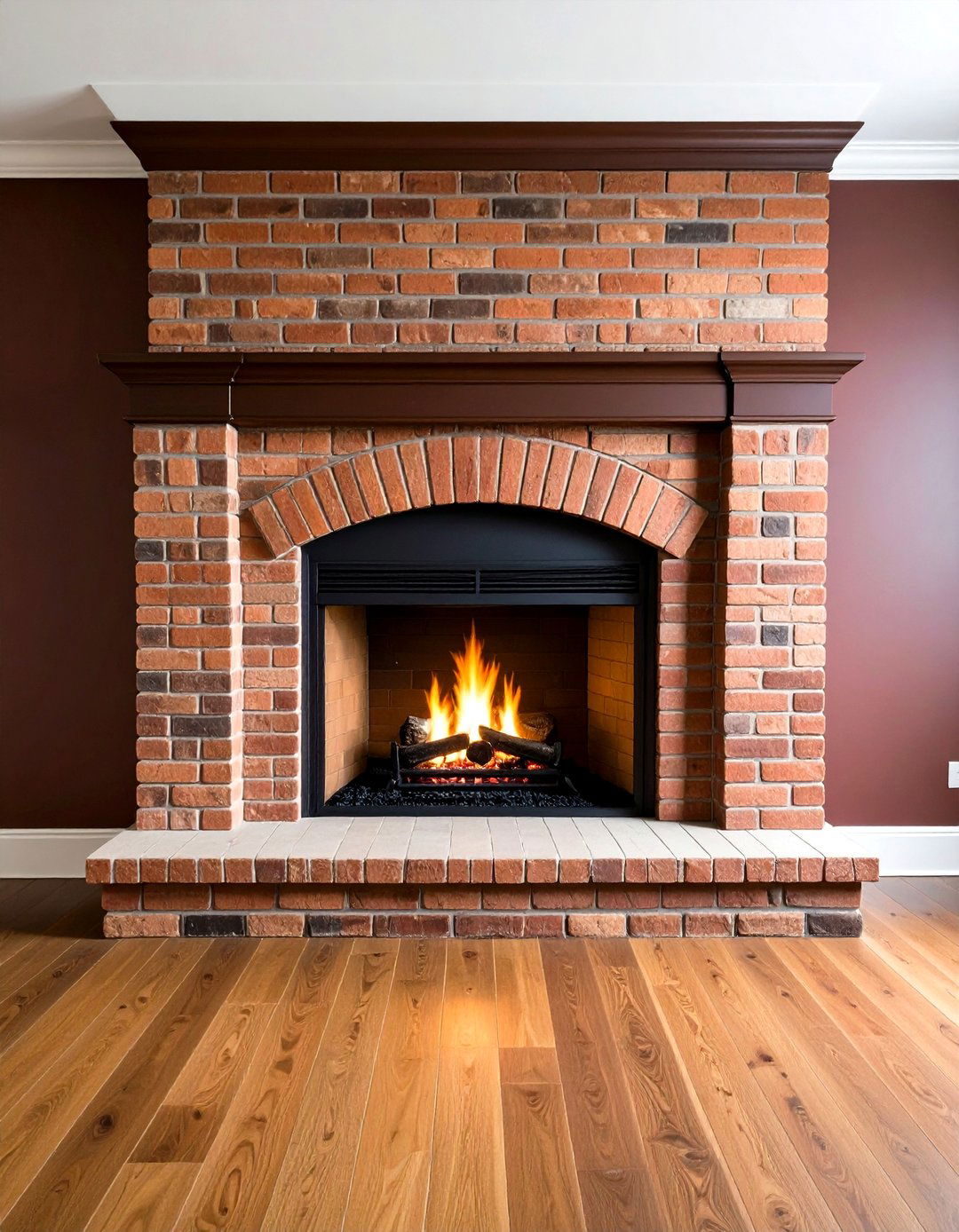
An ombre-painted fireplace shifts gradually from dark at the base to light at the crown, drawing the eye upward and adding dynamic movement to plain brick. DIY guides suggest picking three adjacent shades and blending wet edges with a dry brush for seamless transitions. Begin with the deepest hue nearest the firebox where smoke darkens brick naturally, then progress to mid-tone and finally pale tint near the mantel. Keep a mister bottle handy; lightly spritzing new paint delays drying so gradients stay workable. Finish with flat clear coat to even sheen. The finished ombre fireplace feels artistic yet surprisingly subtle once styled.
20. Faux-Marble Fireplace Elegance with Paint
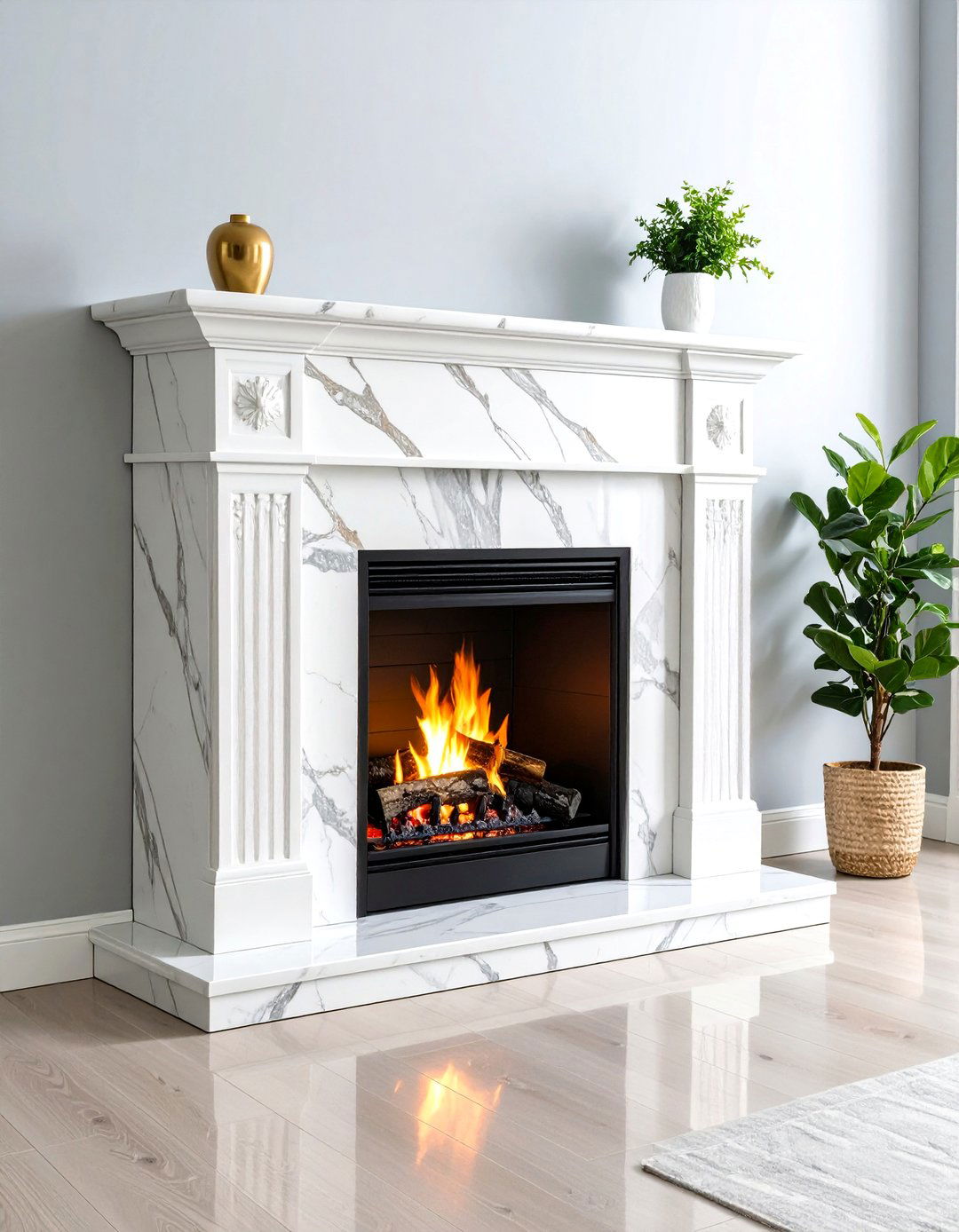
Painting a dated wood or marble-vein surround with faux-finish techniques produces the luxe look of stone for a fraction of the cost. Step-by-step guides recommend sanding, priming, then layering feathered veins in slightly tinted glaze over a pale gray base until the pattern looks convincingly organic. Use a fine artist’s brush for narrow capillaries, softening with a dry lint-free cloth before the glaze flashes. Finally, roll on two coats of crystal-clear, heat-safe polyurethane to impart realistic depth and easy cleaning. Pair the freshly marbled fireplace with minimalist décor to let the veining command attention without competing visual noise.
Conclusion:
From crisp whites and calming sages to bold blacks, ombre fades, and metallic bronze, paint lets a fireplace mirror any design story while staying budget-friendly and safe when you choose heat-rated products. Sampling colors under both firelight and daylight helps reveal true undertones, and priming with masonry-specific formulas ensures every finish—whether chalky limewash, textured German smear, or sleek satin enamel—stands up to sparks and soot. Small details like matching sheens, sealing with clear topcoats, and balancing surrounding décor complete the transformation, proving that the right fireplace paint idea can elevate an entire room’s mood in a single weekend.


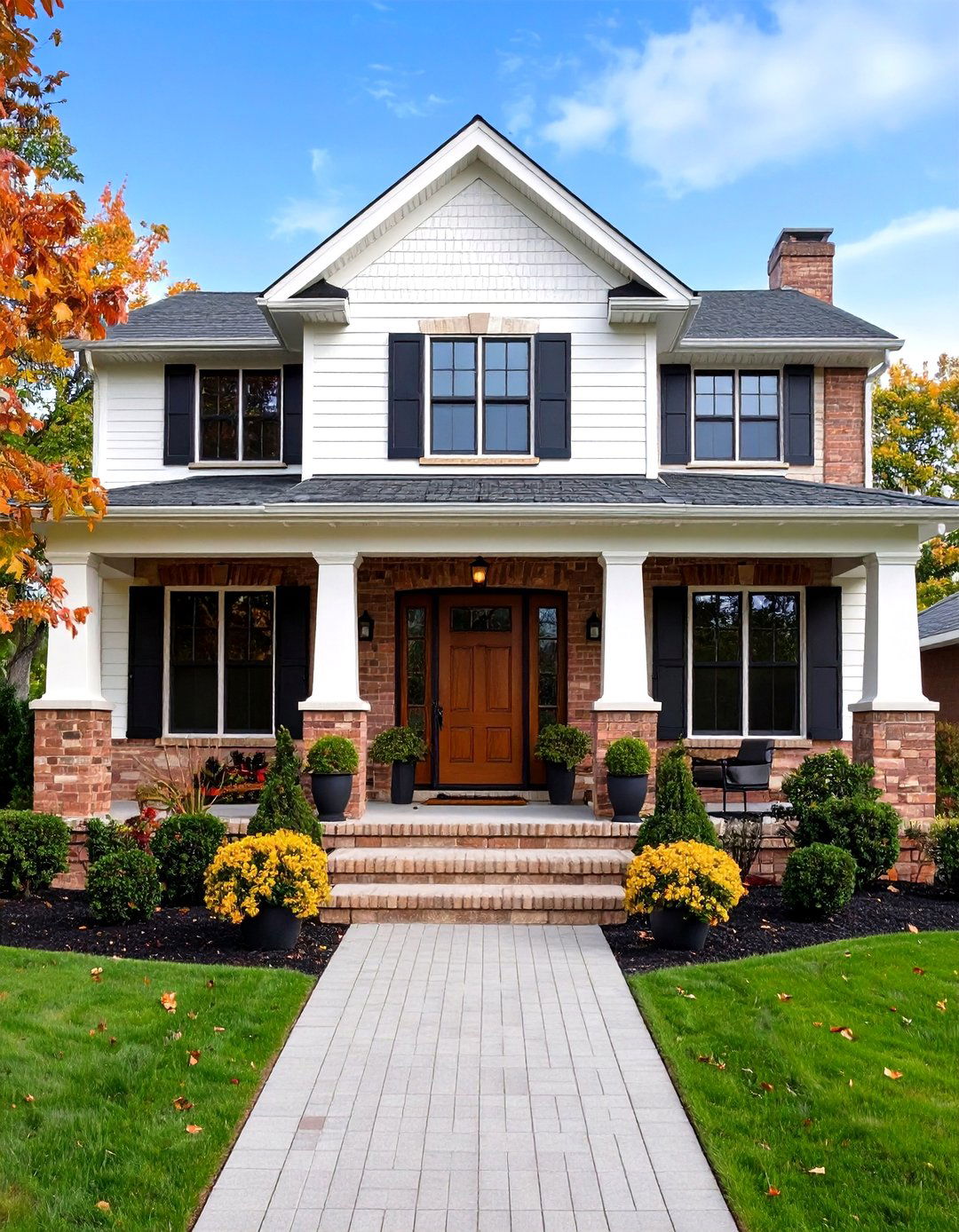

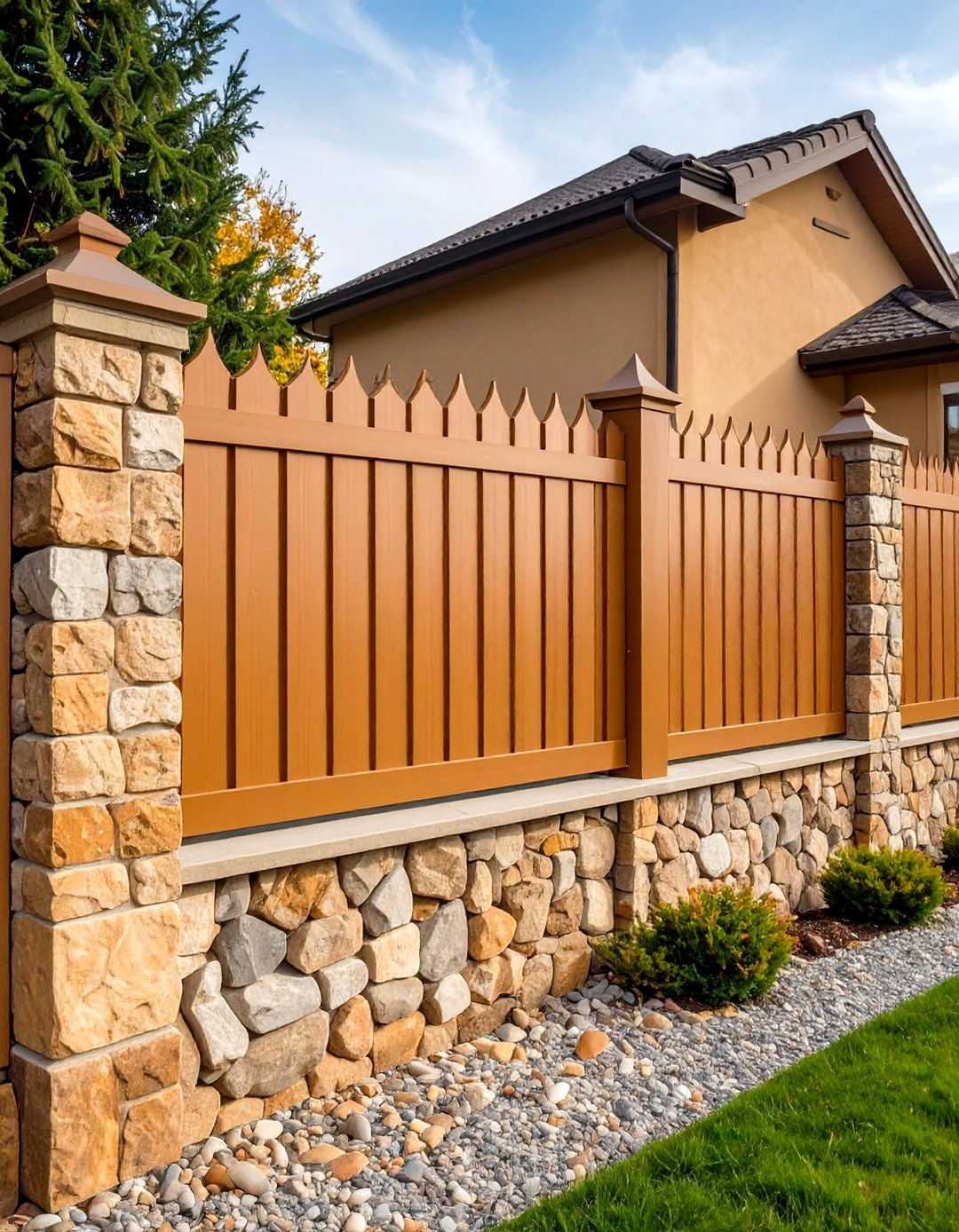
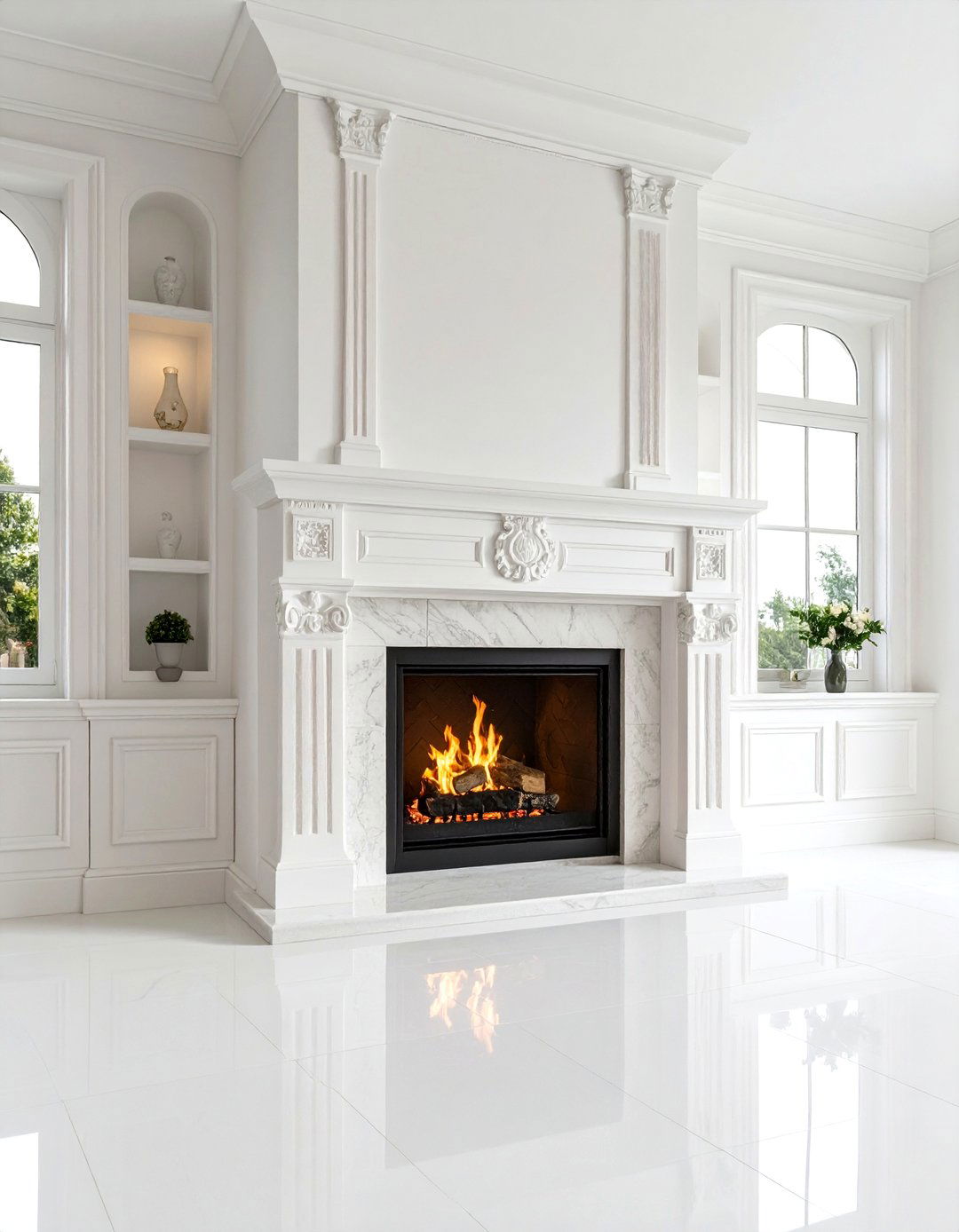
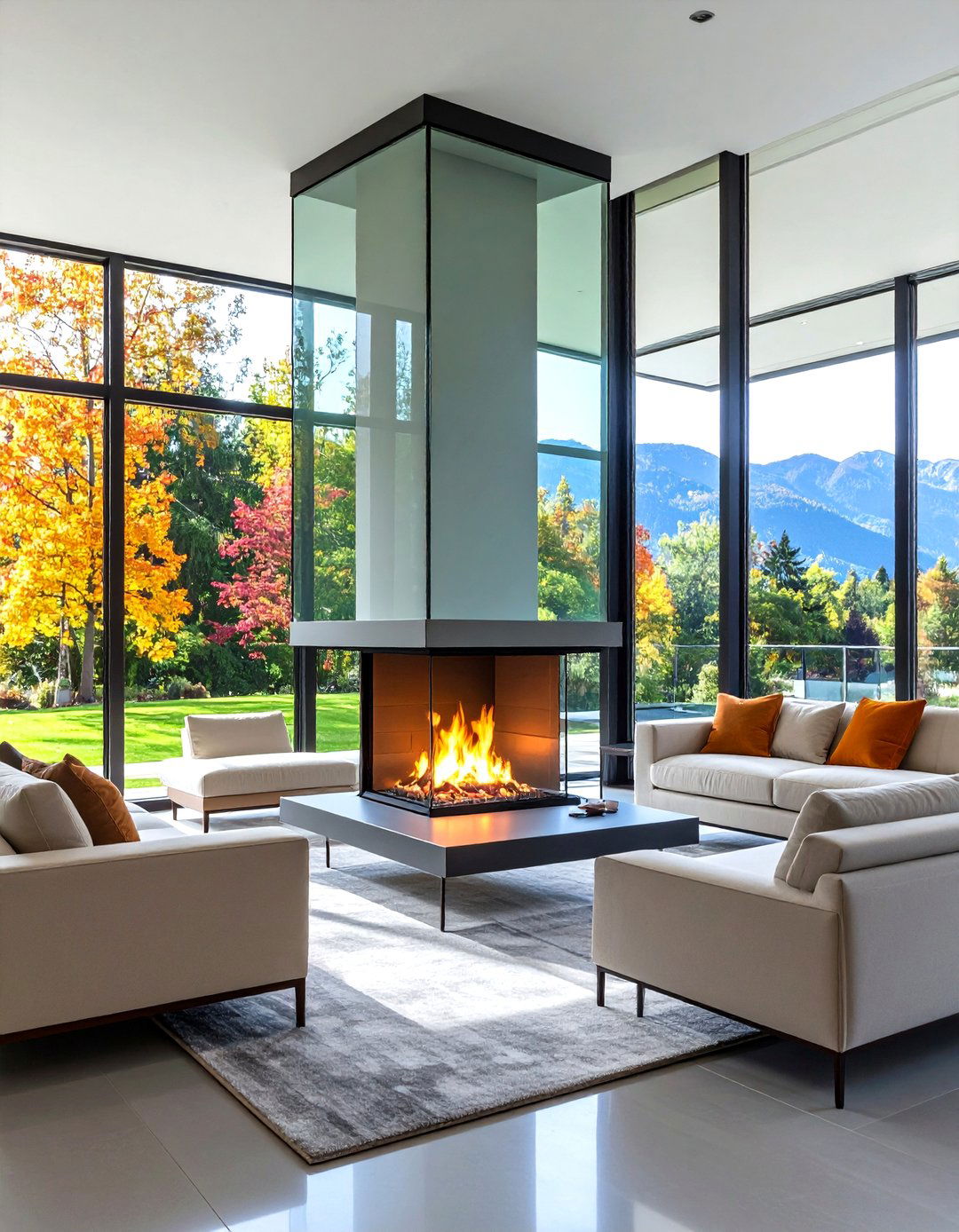
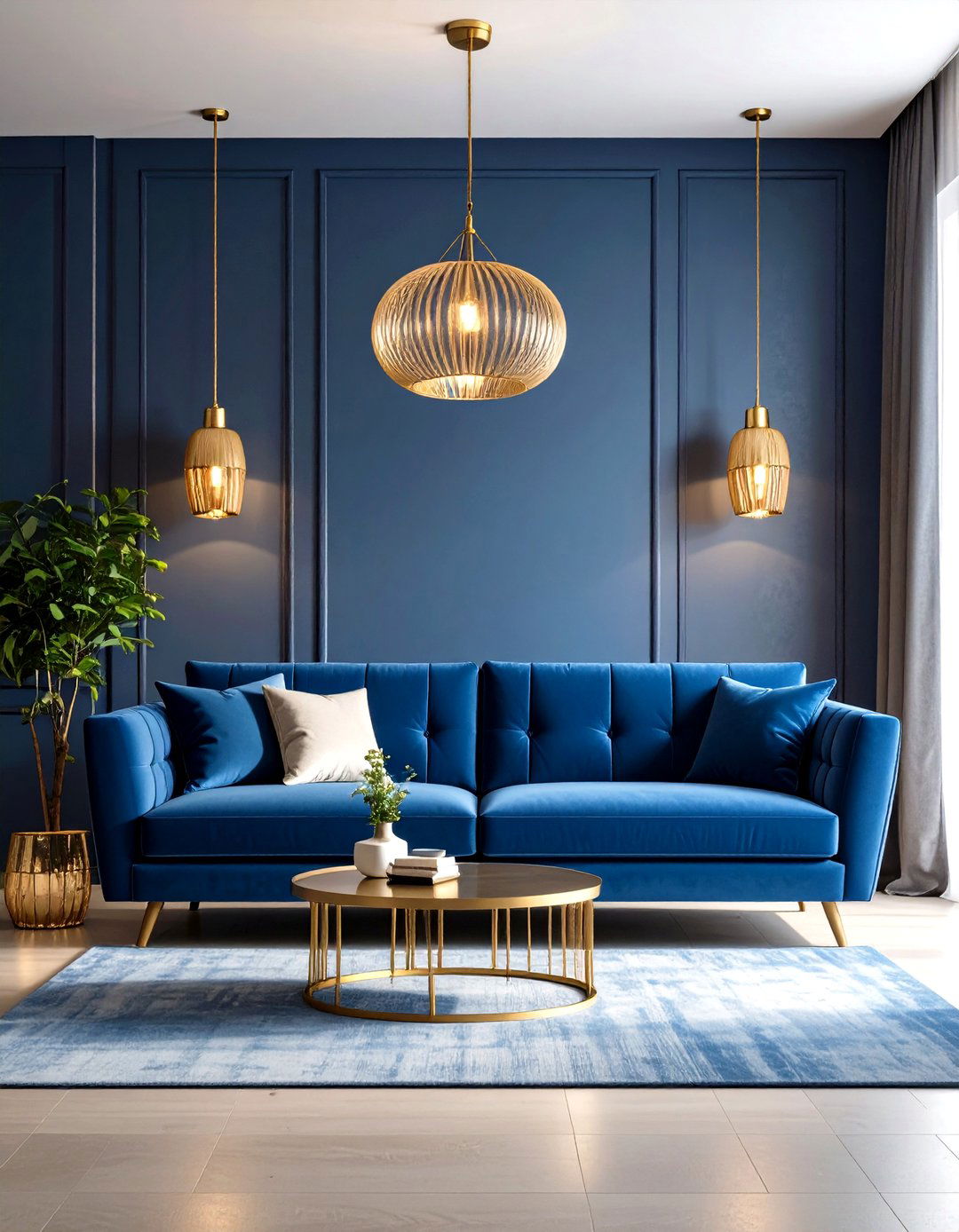
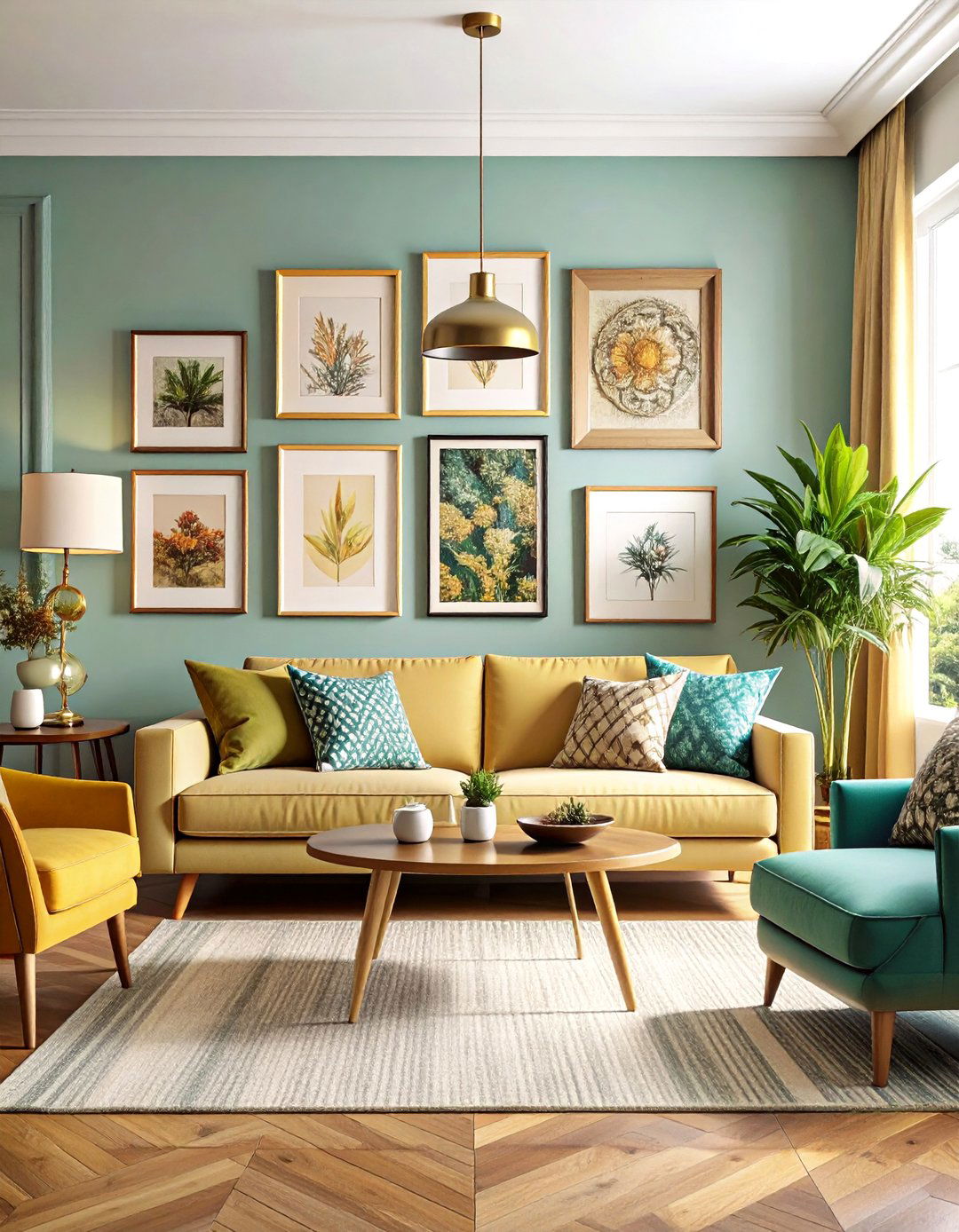

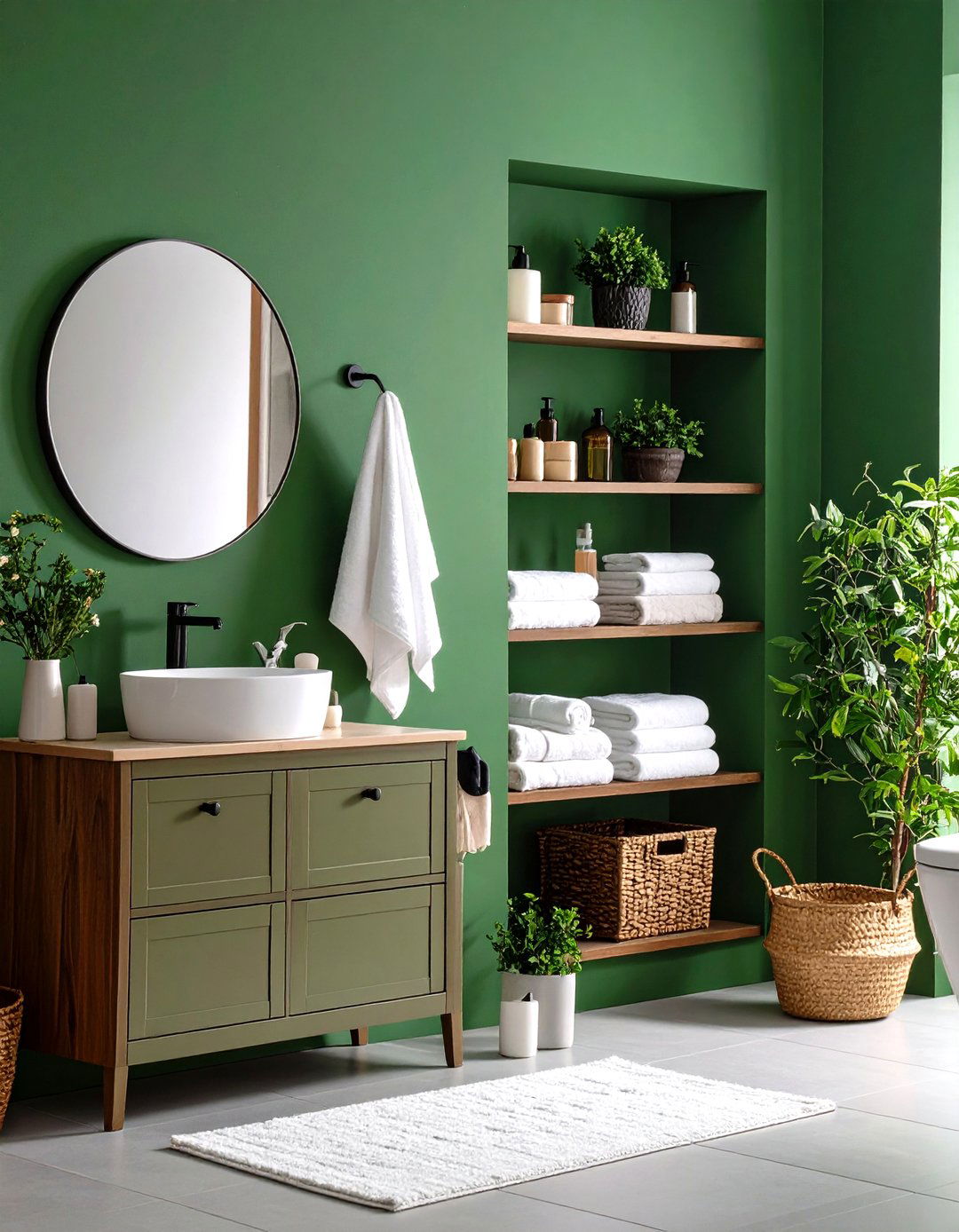
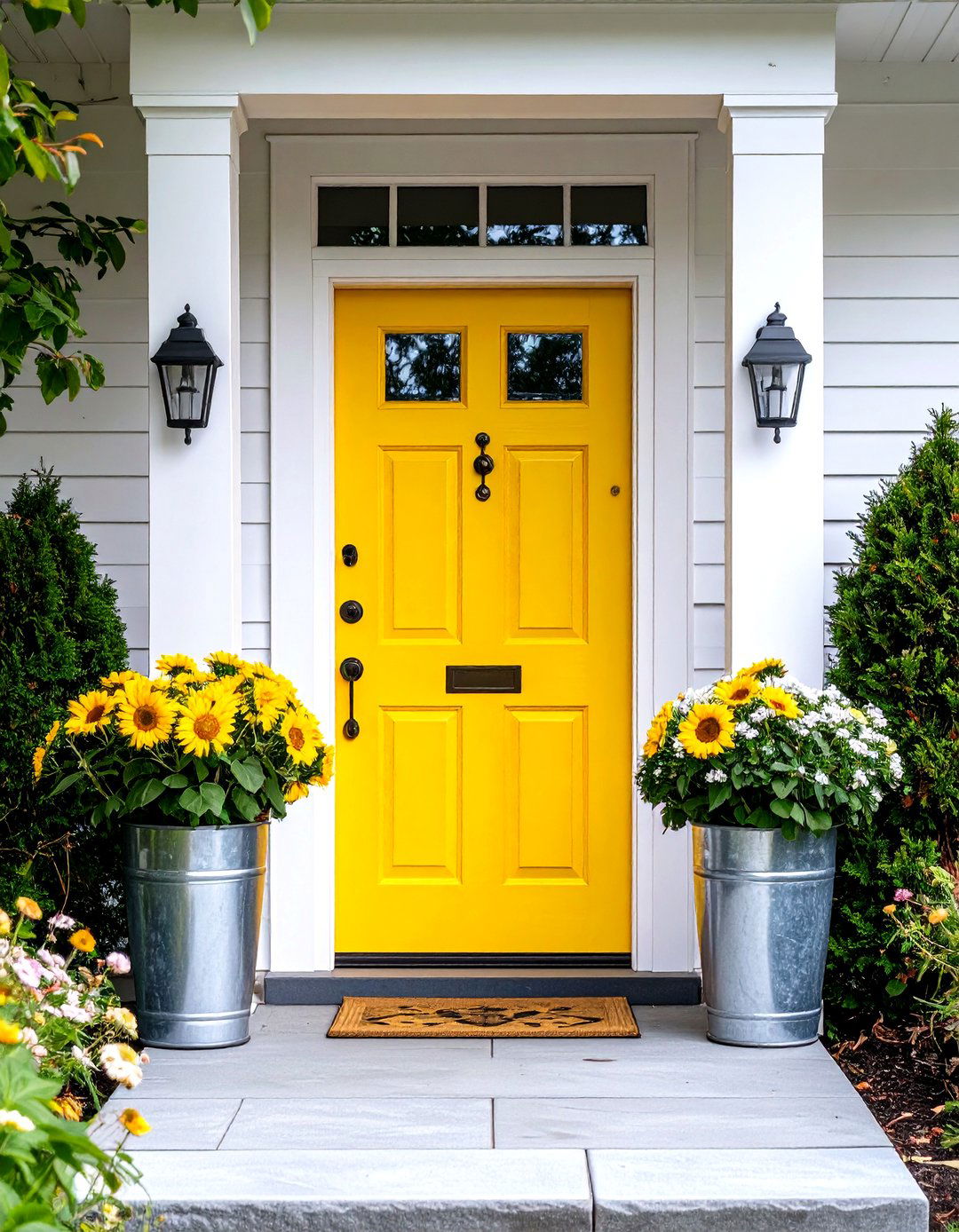

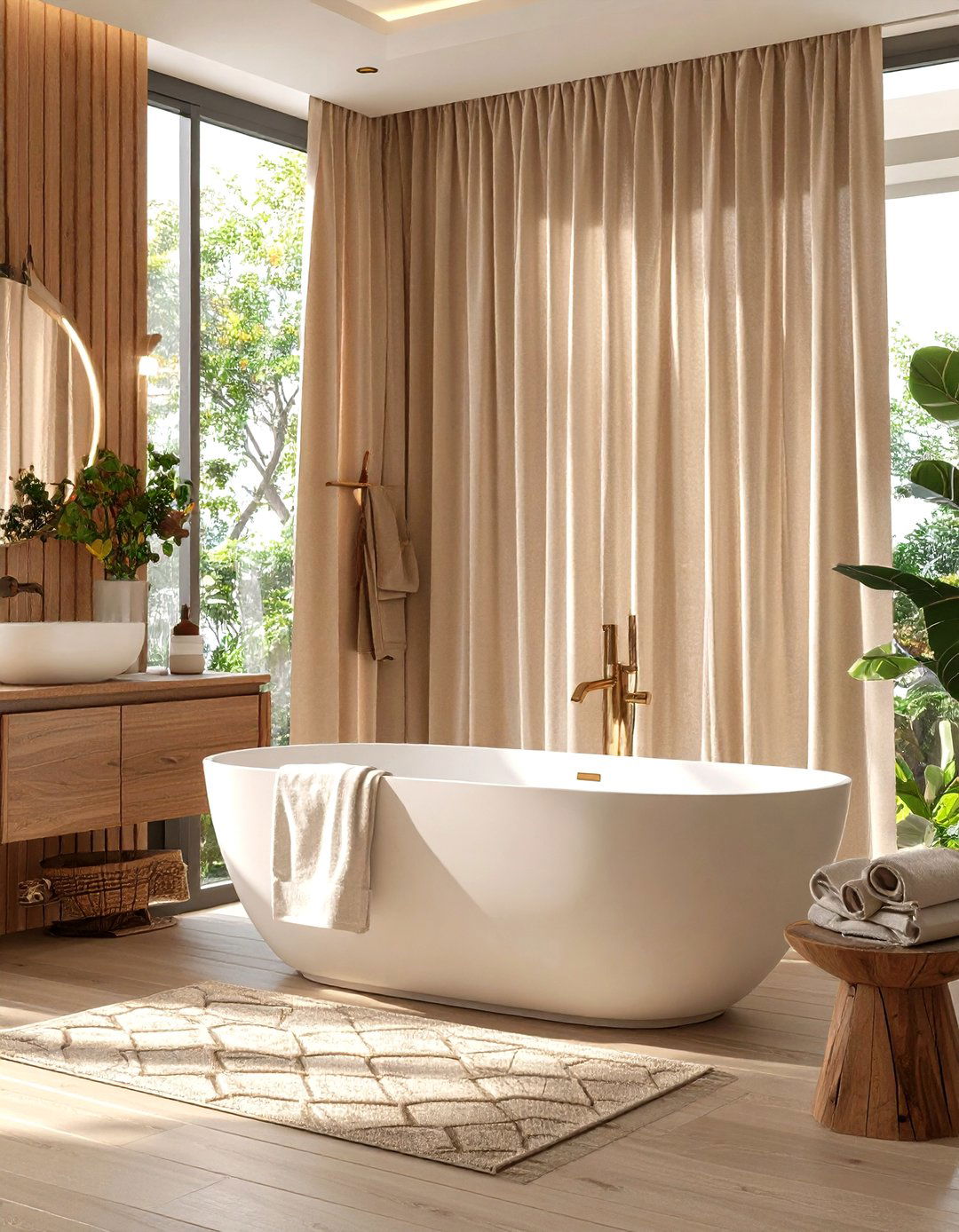
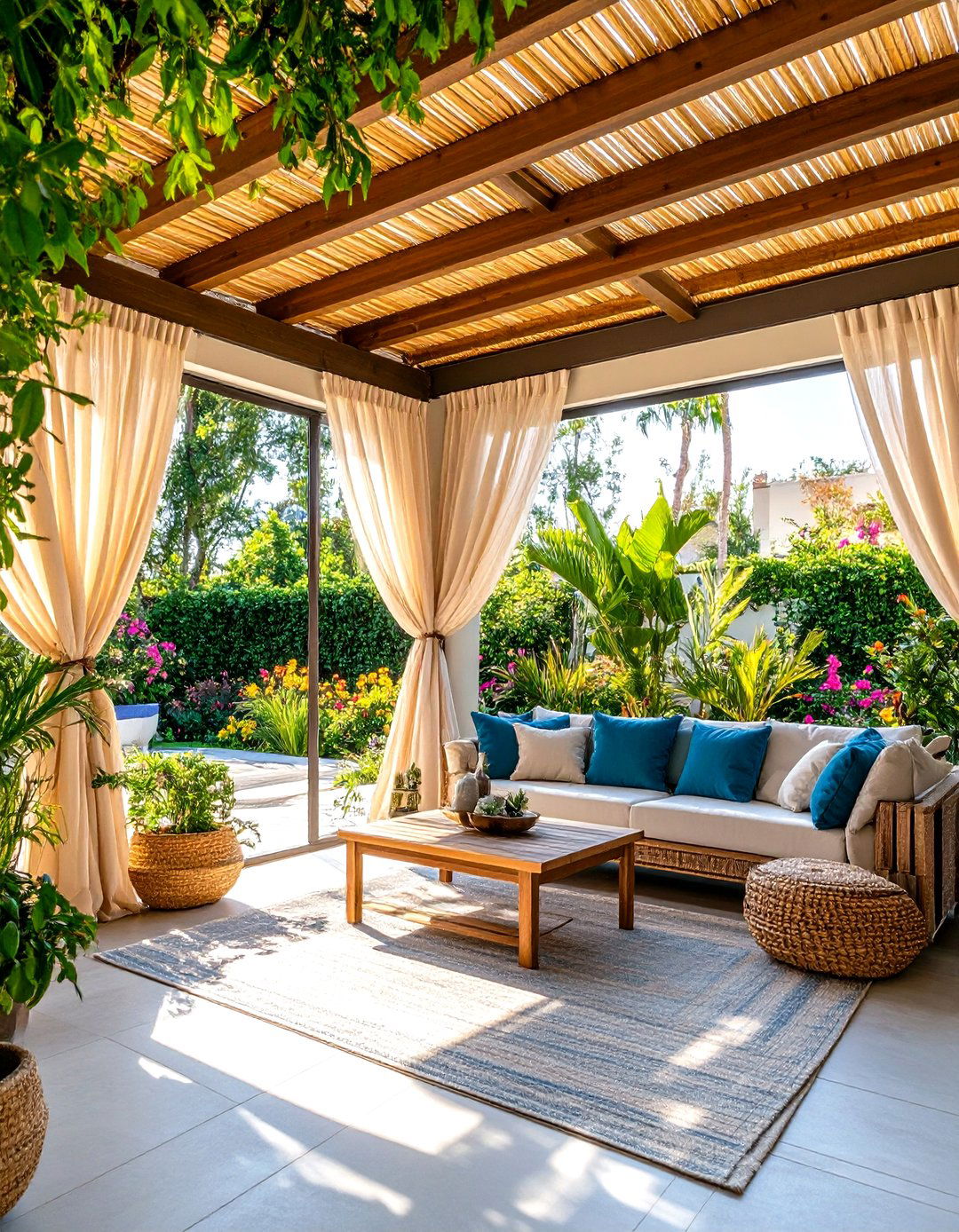
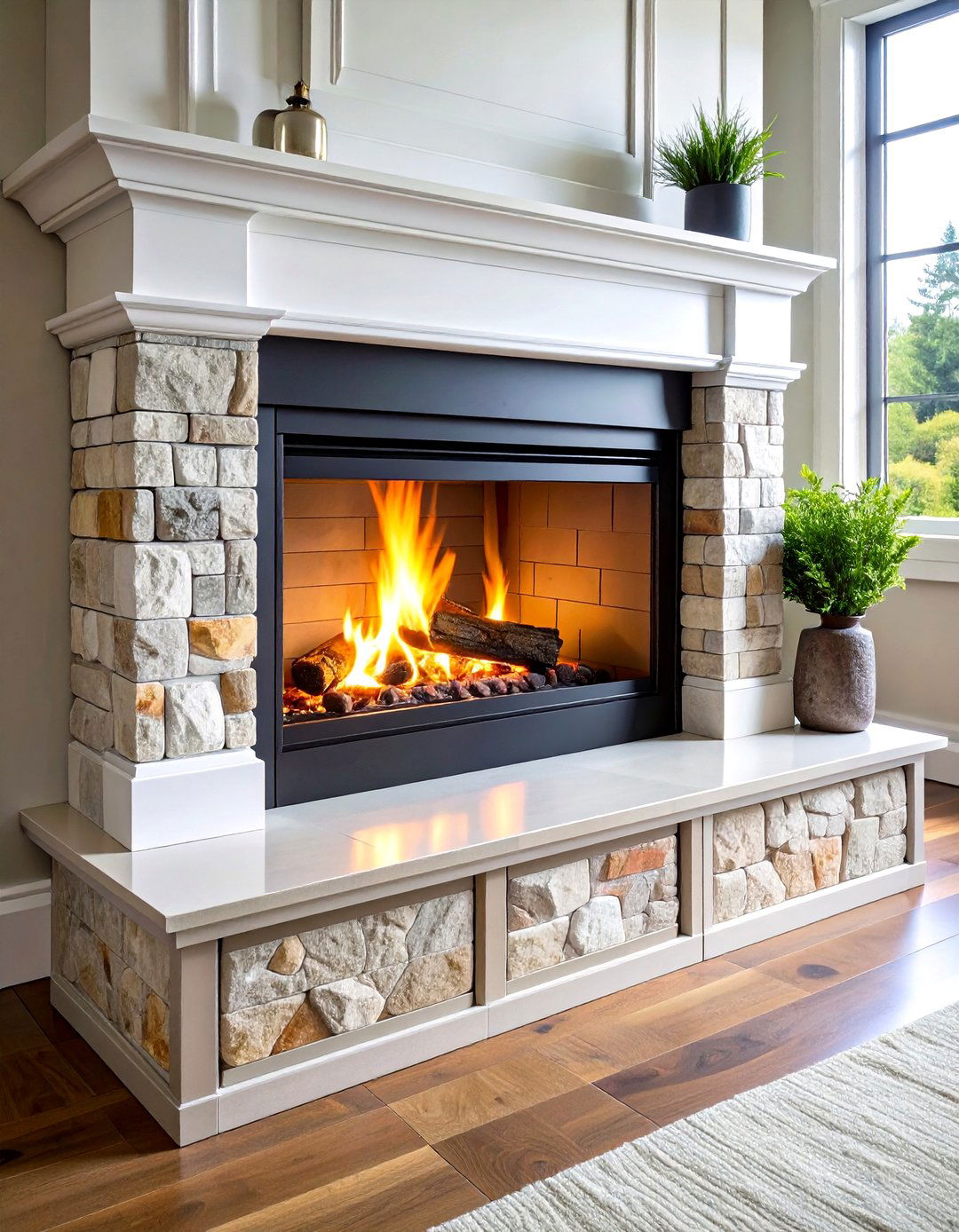
Leave a Reply